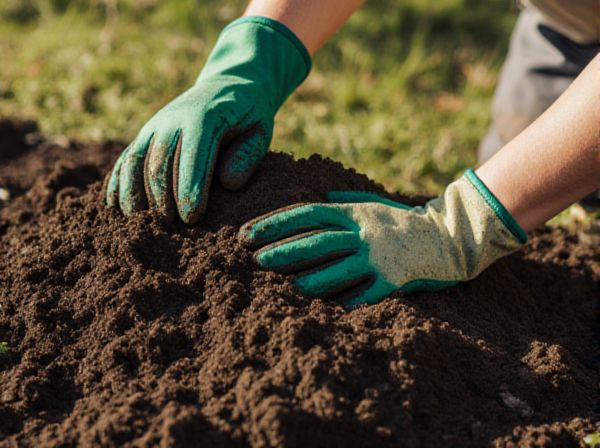
Finished compost vs immature compost Illustration
Finished compost is dark, crumbly, and odorless, indicating it has undergone complete decomposition and is rich in nutrients ready to enhance soil health. Immature compost, on the other hand, retains recognizable feedstock materials, may emit unpleasant odors, and can contain phytotoxic substances harmful to plants. Using finished compost improves soil structure and fertility, while immature compost risks stunting plant growth and attracting pests.
Table of Comparison
| Aspect | Finished Compost | Immature Compost |
|---|---|---|
| Appearance | Dark brown, crumbly, soil-like texture | Greenish, clumpy, and uneven texture |
| Odor | Earthy, pleasant smell | Strong ammonia or sour odor |
| Moisture Content | Balanced, not soggy or dry | Often too wet or too dry |
| Temperature | Close to ambient, stable | Elevated, indicating ongoing decomposition |
| pH Level | Neutral to slightly acidic (6.5-7.5) | Higher pH, often alkaline |
| Nutrient Stability | Stable nutrients, ready for plant use | Nutrients unstable, may harm plants |
| Pathogens & Weed Seeds | Effectively eliminated | May contain harmful pathogens and viable weed seeds |
| Effect on Plants | Promotes healthy growth | Can inhibit growth due to phytotoxins |
Key Differences Between Finished and Immature Compost
Finished compost exhibits a dark, crumbly texture with an earthy smell, indicating complete decomposition and stability, while immature compost remains clumpy, often emits ammonia or sour odors, and contains phytotoxic substances harmful to plants. Nutrient availability is higher and more balanced in finished compost, promoting healthy plant growth, whereas immature compost can immobilize nutrients, leading to nutrient deficiencies in soil. Microbial activity in finished compost is stabilized, contrasting with the high microbial respiration and heat generation found in immature compost.
Physical Characteristics of Mature vs. Immature Compost
Finished compost exhibits a dark brown to black color with a crumbly texture, indicating a stable organic matter composition and minimal odor. Immature compost retains recognizable feedstock materials, appears lighter in color, and often has a strong ammonia or sour smell due to incomplete decomposition. The physical structure of mature compost promotes aeration and moisture retention, whereas immature compost tends to be denser and may compact easily, limiting microbial activity.
Nutrient Content Comparison: Finished vs. Unfinished Compost
Finished compost contains higher levels of stable nutrients like nitrogen, phosphorus, and potassium, which are more readily available for plant uptake compared to immature compost. Immature compost often has elevated concentrations of ammonia and organic acids, which can inhibit plant growth and reduce nutrient availability. Properly matured compost exhibits a balanced nutrient profile with lower phytotoxic compounds, promoting healthier soil microbial activity and enhanced fertility.
Benefits of Using Finished Compost in Your Garden
Finished compost enriches soil with essential nutrients like nitrogen, phosphorus, and potassium, promoting healthier plant growth and increased crop yields. It improves soil structure by enhancing aeration, water retention, and microbial activity, leading to stronger root development and disease resistance. Using finished compost reduces the need for chemical fertilizers and minimizes weed growth, contributing to sustainable gardening practices.
Risks of Applying Immature Compost to Plants
Applying immature compost to plants poses significant risks due to high levels of phytotoxic substances and unstable microbial communities that can inhibit seed germination and root development. Immature compost often contains elevated ammonia and organic acids, which can damage plant tissues and reduce nutrient uptake efficiency. Nutrient imbalances and oxygen depletion caused by incomplete decomposition further stress plants, leading to poor growth and increased susceptibility to diseases.
Signs Your Compost Is Ready to Use
Finished compost is dark, crumbly, and earthy-smelling, indicating complete decomposition and nutrient-rich quality ideal for soil enrichment. Immature compost often retains recognizable food scraps or plant material, emits a sour or ammonia-like odor, and can attract pests due to incomplete breakdown. Key signs your compost is ready to use include uniform texture, absence of heat, and no foul smell, ensuring safe application for garden plants.
How to Test Compost Maturity
Testing compost maturity involves assessing temperature, odor, and texture: finished compost is dark, crumbly, and earthy-smelling, while immature compost often has a sour or ammonia-like odor and a mushy texture. The germination test, where seeds are sprouted in compost samples, helps determine phytotoxicity; healthy seed growth indicates mature compost. Measuring stable temperature below 40degC and using a compost pH range between 6 and 8 further confirm that compost has fully decomposed and is safe for soil application.
Best Uses for Partially Decomposed Compost
Partially decomposed compost, or immature compost, is ideal for use as a soil conditioner and mulch, where nutrient release is slower and less risk of plant root burn occurs. It enriches soil structure by improving aeration and moisture retention, supporting microbial activity without overwhelming young plants. Using immature compost in this way helps gradually build soil fertility while avoiding the negative effects of applying unfinished organic matter directly to sensitive plants.
Composting Methods to Speed Up Maturation
Finished compost exhibits a dark, crumbly texture with a rich earthy aroma, indicating complete organic matter decomposition and nutrient stabilization. Immature compost contains recognizable feedstock, high moisture, and phytotoxic substances, which can inhibit plant growth. Techniques such as thermophilic composting, frequent turning, and aeration accelerate microbial activity, rapidly raising temperature and enhancing oxygen flow to speed up compost maturation effectively.
Troubleshooting Immature Compost Problems
Immature compost often exhibits strong ammonia odors, poor texture, and slow nutrient release, indicating incomplete decomposition caused by insufficient microbial activity or imbalanced carbon-to-nitrogen ratios. Troubleshooting strategies include extending the composting period, turning the pile to improve aeration, and adjusting moisture levels to create optimal conditions for microbial breakdown. Ensuring proper temperature control between 135degF and 160degF promotes pathogen destruction and accelerates maturation, resulting in finished compost rich in humus and beneficial microorganisms.
Finished compost vs immature compost Infographic

 gardendif.com
gardendif.com